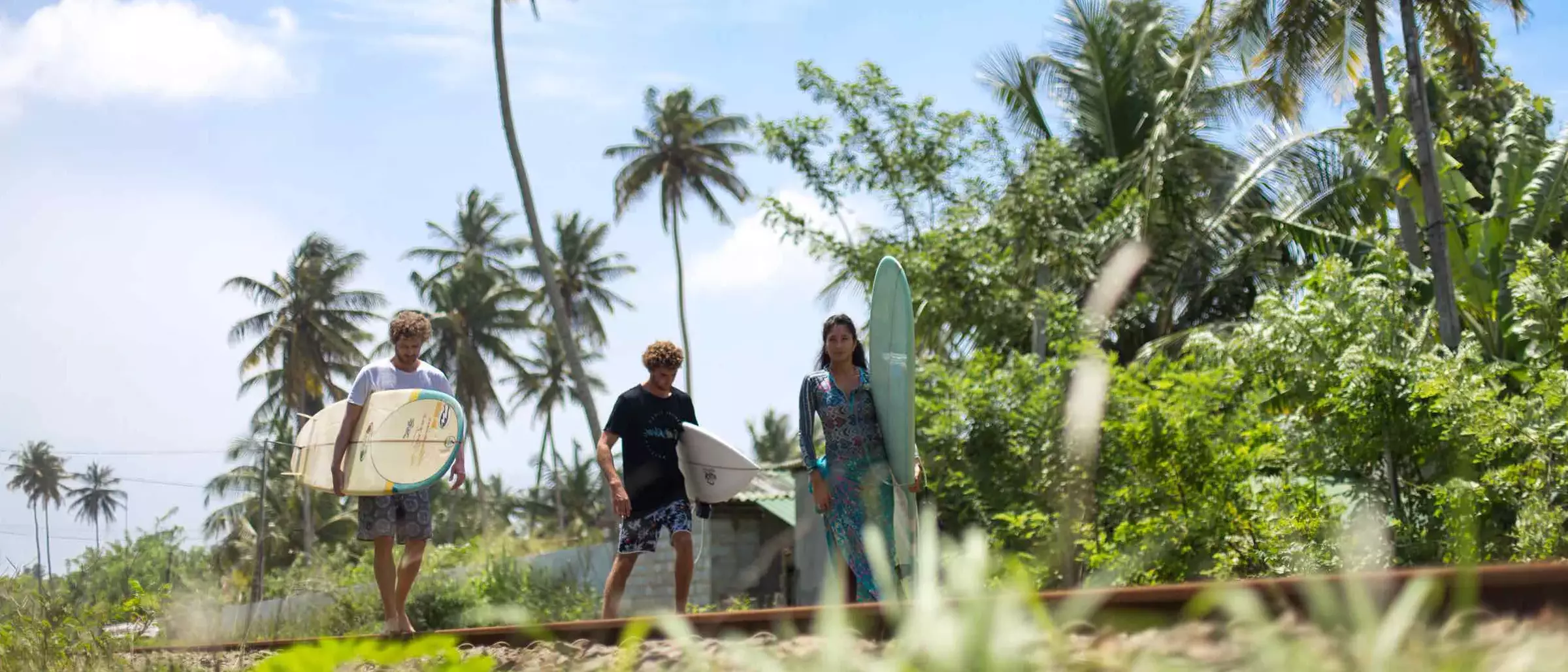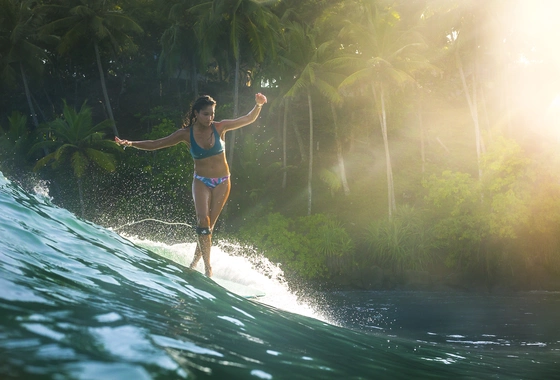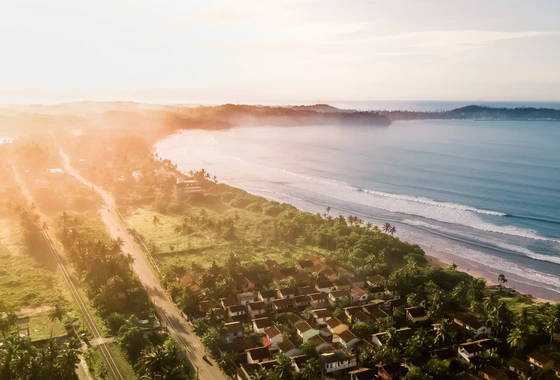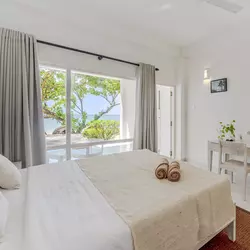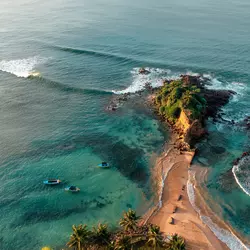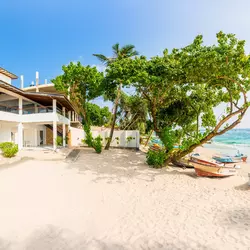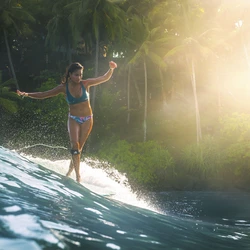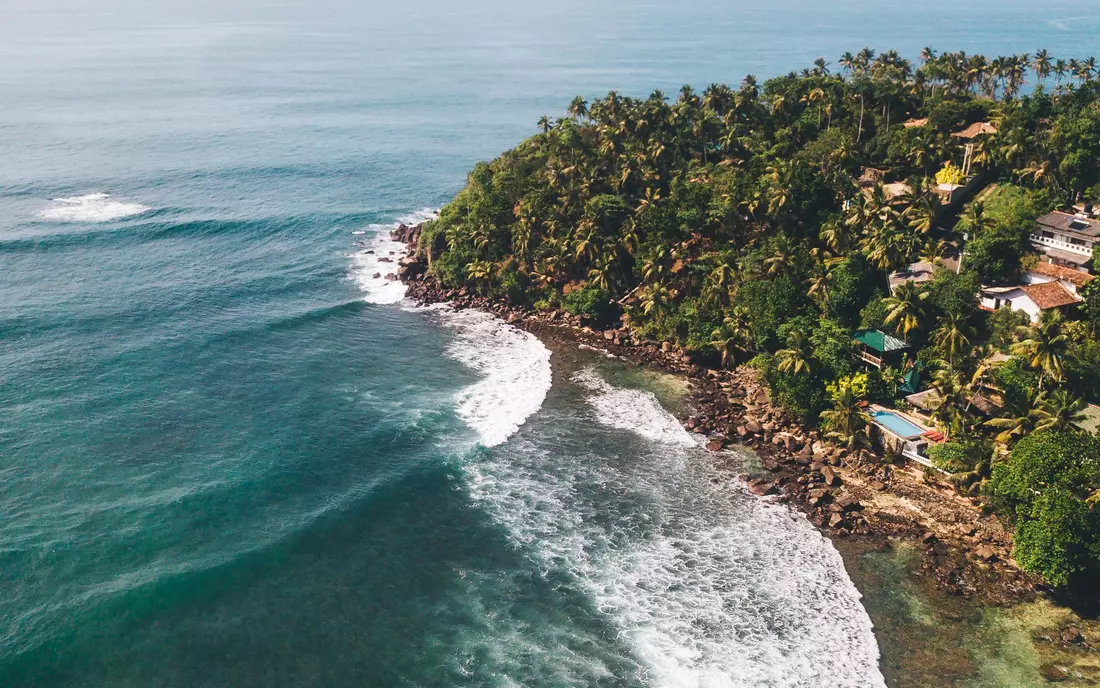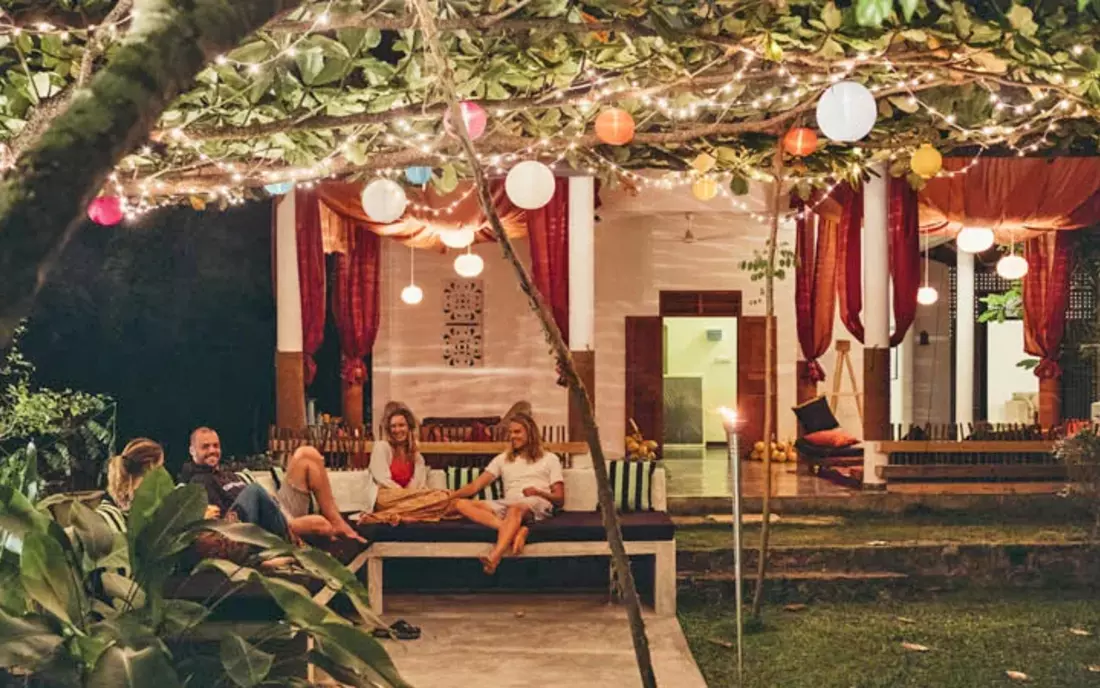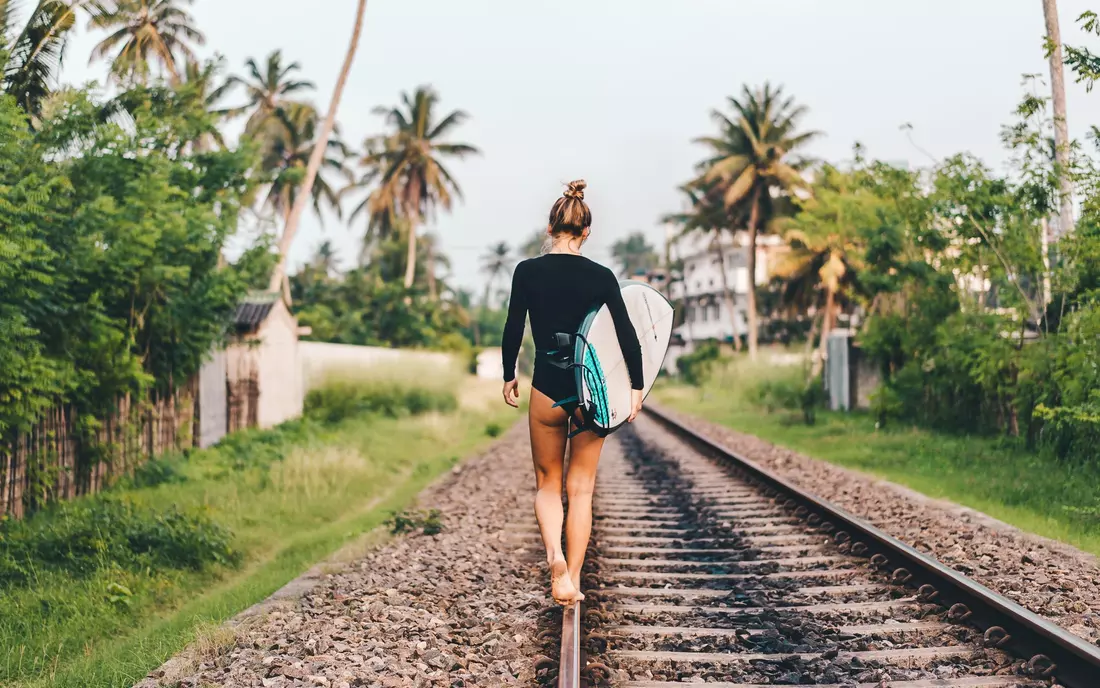Overview
All Surf Camps in Sri Lanka
Travel Informations
Surf Camp Sri Lanka Informations

Best travel time
The tropical climate of Sri Lanka is influenced by the monsoon, which divides the island into two climatic zones. The monsoon season in the south-west runs from May to September with sometimes heavy rainfall; in the southeast, the monsoon rainy season lasts from October to January. The best travel times therefore depend on the region. On average, however, Sri Lanka has 330 sunny days a year due to the two-part climate and we recommend that you use the cold German winter months for your surf trip.
Air & water temperature
In the south, the region of the surf camps, you can expect an average air temperature of 30°C and water temperature of 28°C all year round. In the central highlands, however, there can even be snow in winter. With an average temperature of 16°C, you should think about long clothes if you want to travel the highlands.
Wetsuit
You don't need a wetsuit. With board shorts and bikini you are in the right place all year round!
Surf spots Southwest Sri Lanka: November – April
Hikkaduwa
The surf center in the southwest with several surf shops, surf schools and surf spots offers both reef breaks and beach breaks. At the main beach break in Hikkaduwa it is super easy to learn to surf and make your first attempts on a surfboard.
Benny's
Located off Hikkaduwa is Benny's, a left-hand reef break. Runs well in western or south western swell, 3ft-5ft and mid to high tide. Especially good for advanced surfers or intermediates who want to reach the next level.
Midigama Left
Left point break for all levels. Runs well in northerly winds and from 3ft-5ft.
Midigama
Right Righ Reefbreak for more experienced surfers. Runs well in southwest, south swell and 3ft-5ft.
Unawatuna
Bay off-shore reef break for experienced surfers. Runs well in northerly winds and from 3ft-5ft.
Mirissa
Great, idyllic location with waves breaking left and right at the end of the beach. The reef break for all levels runs well from 3ft-5ft.
Weligama
Nice fishing town with beach break - left and right. Great for beginners and advanced. The wave runs 400m long in good conditions!
Surf spots Sri Lanka Southeast: May – October
Arugam Bay
A-Bay is about 300km east of Hikkaduwa and is the southeastern counterpart when it comes to surfing. Beach cafes, restaurants and beautiful beaches await you in Arugam Bay. It has a chilled vibe and is home to several surf camps. Arugam Bay boasts a consistent reef break with rights and lefts for all levels.
Elephant Rock
Right hand point break, works well in south east and south swells and from 3ft-5ft. Super nice and easy for all levels and in a fantastically beautiful setting.
Peanut Farm
Can be reached by tuk-tuk and via a small path to the beach. But then there is a good chance that you will have the beautiful Right all to yourself.
Okanda
Fast wave breaking to the right. The reef break is best for intermediate surfers, works well in south easterly winds and from 6ft-8ft.
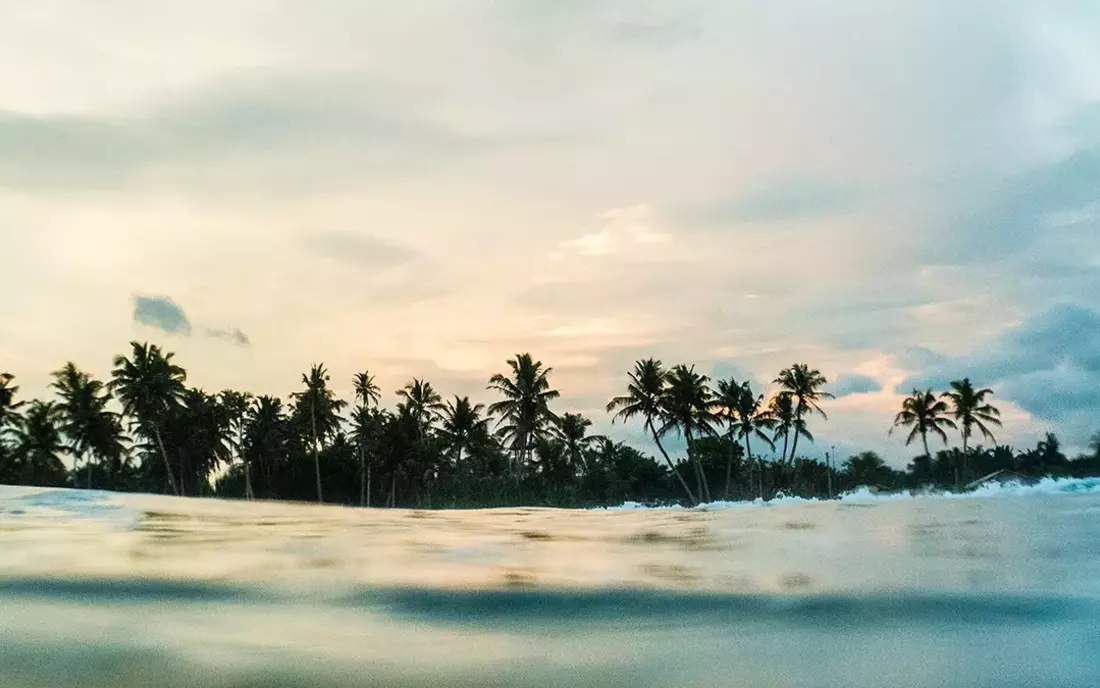
Flight arrival
Permanently cheap flights to Colombo (CMB) can be found primarily with the airlines Qatar and Emirates. With Qatar the transport of surfboards is free of charge, with Emirates the board bag up to 2m and 23kg is also accepted as a second piece of luggage. The flight costs are comparatively cheap and average around €550-650. Most airlines make a short stopover in Dubai or Qatar, but there are also many direct flights from Germany and Switzerland. We are happy to support you in finding a flight and give you tips on what you still need to consider in Sri Lanka, e.g. visa.
Entry
In general, entry is possible with a passport (even a temporary one), but not with an identity card. Children also need a valid passport. The documents must be valid for at least six months.
A visa is also required for Germans. This should be applied for in advance as an "Electronic Travel Authorization" (ETA) online at www.eta.gov.lk (it is essential to use the official website and make sure that everything is entered correctly). This can also be applied for at a Sri Lankan mission abroad or via a German tour operator. The visa can also be issued upon arrival at the airport for a surcharge. The fee for a single-entry visitor or business visa valid for up to 30 days is US$35. If the visa is issued upon arrival at the airport, the fee increases to US$ 40. However, applying for a visitor's visa upon arrival at the airport may involve longer waiting times. Visas for transit travelers (valid for up to two days) and for children under the age of twelve are free of charge. Vaccinations There are no mandatory vaccinations. However, entry requirements for German nationals can change at short notice. It is best to get information from the Foreign Office or a Sri Lankan mission abroad before you travel.
Here are a few tips to ensure that your surfing holiday in Sri Lanka with Puresurfcamps is a complete success:
Do's
- Drink tea and pack a rich yield for home! You will rarely get better tea than here. However, it is best to shop at the factory. In normal shops you often only get the "everyday tea", which can be of inferior quality. A reasonable price for very good quality is around 10 euros per kilo. By the way, there are no exemption limits for tea at customs, so there are no limits to what you can bring with you. As a jewelry lover, you've come to the right place for shopping in Sri Lanka. Jewelry is definitely more beautiful and cheaper than at home due to the country's own stones and low labor costs. You can also have your own designs made and take your very own piece of jewelery home with you. Of course, there are also black sheep among the dealers here, so don't choose the cheapest street dealer and prefer to buy from jewelers with high quality at reasonable prices.
- Eat local food - you rarely get such good and cheap curry! The standard dish is rice and curry with fish or chicken. There are also a number of other delicious dishes that you should definitely try, such as roti (dumplings with different fillings), fried rice (rice with various ingredients, sautéed in a wok), string hoppers (striped pasta noodles) or buriyani (rice dish) .
- If you want to drive short distances, definitely take a tuk-tuk. By far the cheapest and most uncomplicated way to get from A to B. For longer distances and to get to the mountains, the train is definitely suitable. It's very slow though, so if you don't have a reservation, feel free to elbow out for a seat by the window (it's worth it for the great views while driving).
- Take enough cash with you when traveling in smaller towns. There are not necessarily many (working) ATMs here.
Don'ts
- Don't underestimate the spiciness of the food! Sinhala cuisine is some of the spiciest in the world and an excessive dose of spiciness as a dare would not forgive your taste buds. However, the spices also ensure the shelf life of the food. Therefore prefer local food to continental - otherwise the chances of gastrointestinal problems are not too bad.
- The same applies to nature as to the waves - know your limits and don't just rush carelessly into the jungle. On average, 40-50 people are killed by elephants every year. Snakes, crocodiles and leopards are not necessarily tame, so it is essential to follow the rules of the locals on safaris or other excursions.
- Also avoid riding elephants. The much better alternative is to observe them in the wild on safari than to support the exploitation and even abuse of the animals.
- Buddhism is a major religion in Sri Lanka and disobeying any rules is considered a serious offence. This includes in no case disturbing the morning and evening prayers. When visiting temples, also make sure that you dress appropriately (no headgear, take off your shoes and cover your shoulders) and do not stand with your back to the Buddha when taking photos. The Buddhist monks have a very special position, are very friendly and helpful, but may not be touched.
Travel Info
Sri Lanka's Coasts
Sri Lanka means radiant island and keeps what the name promises! One of the most diverse countries in Asia not only convinces with beautiful beaches and great surfing conditions all year round. Culture, nature and the friendliness of the Sri Lankans will inspire you.
The island state of Sri Lanka is located in the Indian Ocean directly below India, on one of the central sea routes between the Middle East and Southeast Asia. Hence, Sri Lanka has been influenced by different cultures from ancient to modern times. While the south was the center of Buddhism, the main Hindu temples can be found in the north and east. Today, in addition to the two religions, Christianity and Islam are also practiced. The population is mostly Sinhalese, with the Tamils being the largest of the ethnic minorities, which also includes the Veddas (Sri Lankan natives).
The most consumed and exported product of Sri Lanka is tea. It is not for nothing that Sri Lanka was originally called Ceylon. The famous tea growing areas are in the central highlands. There are mountains up to 2500m high. Coffee and rubber are grown on the lowland plains.
The coastal areas line palm beaches, of course with lots of coconuts. Another industry is fishing. Sri Lanka is also known for its traditional healing art Ayurveda, which is now also known in Europe for numerous cosmetic products. Life in Sri Lanka is cheap and pleasant. Thanks to the infrastructure created by colonization and the high level of education, Sri Lanka is very pleasant to travel to and you meet friendly and helpful people everywhere. The language culture was also strongly influenced by the colonial powers; English is taught from the first grade and most locals in Sri Lanka also speak English.
When traveling to Sri Lanka, you should definitely make a detour into nature, for example to the Gal Oya National Park. In the jungle there are various species of monkeys, monitor lizards, crocodiles, leopards and the highly endangered Asian elephants. The bird species are just as diverse and colourful. Whether on safari or just on a small excursion into the hinterland, the beautiful landscape of Sri Lanka inspires again and again. Among our worldwide surf camps, a surf trip to Sri Lanka is particularly recommended between late autumn and spring.
Surf Lessons
Learn to surf in Sri Lanka
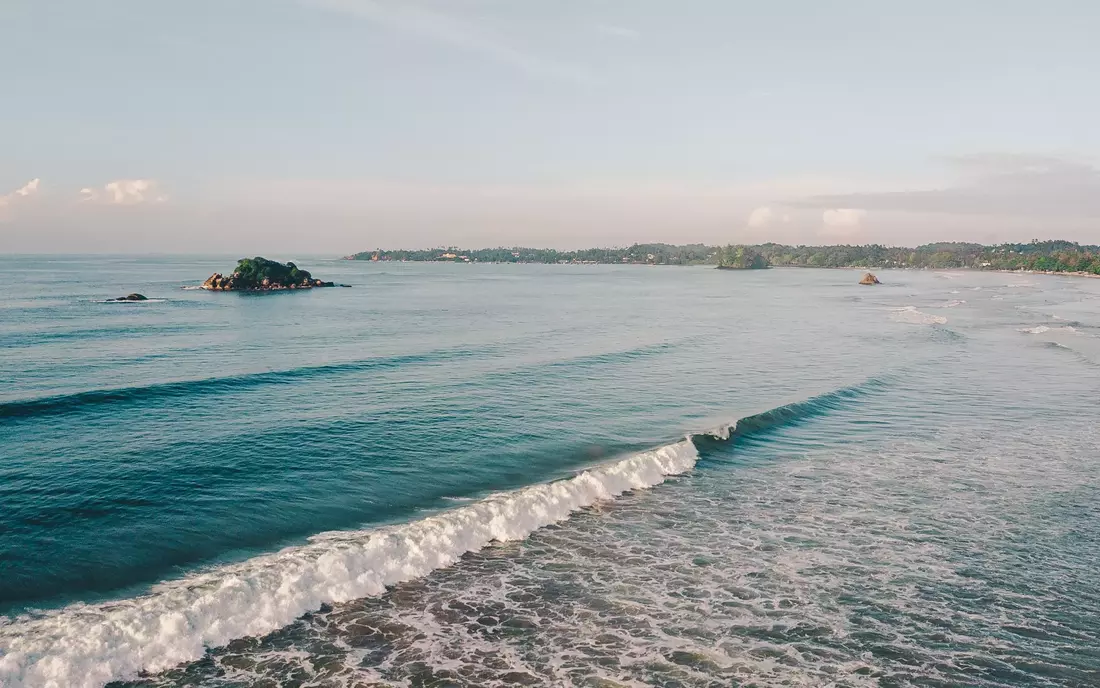
Sri Lanka has emerged in recent years as the perfect surfing destination during the winter months and it doesn't come from anywhere.
The wave season is from October to April and thus in the time of our winter. What a stroke of luck for all surfers who want to enjoy warm water, great waves and perfect weather!
The wind is offshore and the swell is in the right direction for the southwest coast of Sri Lanka. The waves are generally medium sized, not overly powerful and are ideal for learning to surf or improving your technique as an advanced surfer.
In addition, the flights from Germany, Austria and Switzerland can be booked very cheaply and sometimes without stopovers. The easiest way to get surfing to Asia is with a surf tip to Sri Lanka.
Sri Lanka
Surf & Yoga Sri Lanka
In this beautiful surf camp you will spend an all-round carefree surfing holiday!
Show me the Surf & Yoga Sri Lanka!
Everything is already included in the room price: surf course, yoga sessions, massage, full board and as many coconuts as you want.
There is a large garden with a yoga deck, stream and very large pool! In the evening, the surf camp is immersed in a magical atmosphere with lanterns, torches and guitar sounds.
Yoga sessions take place at sunset and in the evening we have a barbecue, eat together or have a few drinks at the pool bar. The ideal surf camp for a relaxing surf holiday!
Sri Lanka
Surf House Sri Lanka
The Surf house Sri Lanka is located directly on the beach of Weligama - with great waves to learn to surf and to improve your skills and all that in the warm water in the sun! With perfect surfing conditions from autumn to spring and warm temperatures, Sri Lanka is the ideal winter destination.
Show me the Surf House Sri Lanka!
The tropical island with white sandy beaches, palm trees and jungle, rice and tea plantations in the hinterland and fascinating wildlife fascinates its visitors again and again. With the Surfhouse Sri Lanka you live in the surfing region of Sri Lanka. There is a beach house right on the beach and a cheaper option 100m from the beach.
The rooms are modernly furnished and you have the choice between single, double, deluxe and triple rooms. The delicious, rich breakfast is included and you can have dinner together in the rooftop restaurant and end the surfing day comfortably.
With the surf courses you have the choice between two different levels and if you are already more experienced, you can take part in surf guiding and get to know secret spots by boat. The course ratio of four students to one surf instructor promises the best learning success. And in Weligama and the surrounding corners there are numerous top spots for all levels! If that is not enough, you can also take part in yoga. The Surf & Yoga Package includes one yoga session and one surf session per day, six days a week. And there are a number of other cool leisure activities, such as movie nights, pool and beach games, boat trips, table tennis or taking the party bus to the best beach parties. Off into the warmth and into the waves at the Surfhouse Sri Lanka!
Surfing
Sri Lanka's surfing regions
The surfing areas in Sri Lanka can be divided into two regions. Most of the surf spots on the southwest coast are lined up on the stretch between Hikkaduwa and Tangalle. Here you will always find a suitable wave somewhere and a large selection of spots.
The east coast around Arugam Bay is the second surfing region in Sri Lanka. The best wave in the region, Main Point, is located in the small surfing town of Arugam Bay. There are more surf spots for every level to the north and south.
The surfing season on the east coast runs from May to October and on the south west coast from November to April.
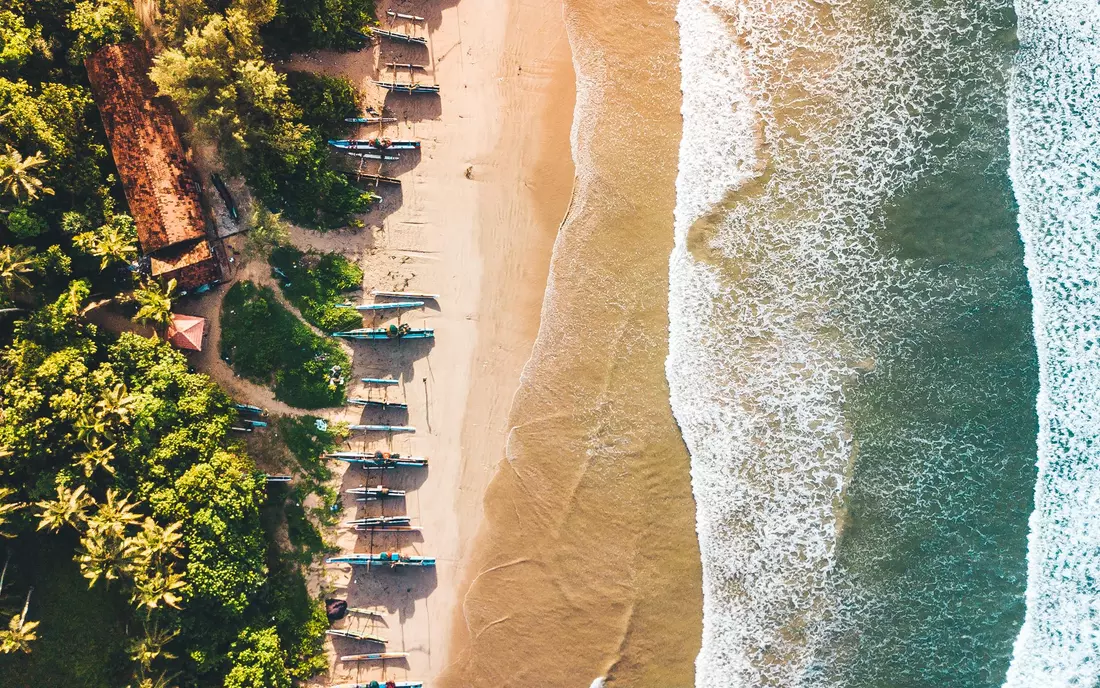
The most frequented region in Sri Lanka by surfers is the area around Hikkaduwa. There are countless good waves for all levels. Hikkaduwa offers surf spots for every taste: whether A-Frame, Rivermouth or Beachbreak. The region attracts surfers and travelers from all over the world with its perfect mix of nightlife, infrastructure and good waves.
The beach break Dewatta Beach, about ten minutes north of Unawatuna, is very suitable for beginners. Advanced surfers tend to have fun here with big swells. The wave can then offer nice long lefts and rights.
Also ten minutes south of Unawatuna is beautiful Dalawella Beach. The bottom is rocky and depending on the sand it can get very shallow at low tide. The spot is therefore reserved for experienced surfers.
Sri Lanka's most famous beginner's spot is in the long, sandy bay of Weligama. Surf lessons are offered, boards are rented and there are several peaks. Since Weligama is one of the tourist hotspots, it can get a bit crowded in the water. Beginners will definitely have fun here!
Mirissa was once considered a laid-back hippie town, but is now lively. Sun loungers, surfer bars and restaurants line the beach under palm trees. When the swell is bigger, a rights over reef breaks right in the bay, which is ideal for advanced surfers or longboarders.
The largest town on the south coast is Matara. Directly on site you will find the long beach with several peaks. Medawatta Beach is even nicer. The spot is called "Black Sands" and is about a 10-minute tuk tuk ride behind Matara. The beach break offers waves and fun for beginners and advanced surfers.

Surfing is concentrated around Arugam Bay in the southeast of the country. The best waves run here from May to October. The formerly small fishing village then really comes to life. Surfers from all over the world and locals cavort in and around Arugam Bay. Then it can get a bit crowded in the water, because well-known point breaks such as Whiskey Point, Elephant Rocks or Peanut Farm are suitable for different surfing levels.
The Pointbreak A-Bay, for example, is one of the best points in the world. Here, in perfect conditions, there are long waves straight out of a picture book.
Sri Lanka and Arugam Bay in particular are made famous by the Main Point wave, which peels along the beach and is really fun. It breaks over a mix of reef and sand, requiring you to walk over the reef to get in and out.
A great beginner's spot is Baby Point, which breaks further out in the bay. Only later in the season does this soft wave start to run. Before that, the necessary sand has to be flushed into the bay.
The main spot for beginners and advanced surfers is Whiskey Point. Because something always arrives here, the wave is also called "Magic Wave".
Sri Lanka
Questions and answers about our surf camps in Sri Lanka
What makes surfing in Sri Lanka so special?
All year round, surfers from all over the world travel to Sri Lanka to surf world-class waves, enjoy the diverse coastline and visit beautiful fishing villages. But what exactly makes a surf holiday in Sri Lanka so special? What sets Sri Lanka apart from other surf destinations? This is why you should book a surf holiday in Sri Lanka:
- Diversity: Exotic cultures, tropical temperatures, impressive landscapes and diverse wildlife: Sri Lanka is the ideal travel destination for an adventurous surf trip.
- The Coast: The surfing regions of Sri Lanka are the East and the South West. For beginners and advanced surfers, the two coasts offer a wide variety of surf spots and waves. Depending on the season, you will always find a suitable wave on one of the two sides!
- The waves: Sri Lanka is a year-round wave paradise - for every level! Relaxed waves and countless beach breaks are perfect for learning to surf, first-class surf spots are ideal for advanced surfers.
- Getting there: Flights from Germany, Austria and Switzerland are comparatively cheap for a long-distance travel destination - and in some cases even without stopovers.
- The accommodation: In Sri Lanka you will find a great selection of accommodation - no matter which coast you choose. There is something for every budget and every taste - you are spoiled for choice!
- The landscape: Impressive national parks, extensive sandy beaches, exotic jungles, green forests, hilly tea plantations and impressive mountain landscapes: Sri Lanka's landscape is unique.
- The climate: The tropical climate of Sri Lanka is influenced by the monsoon, which divides the island into two climate zones. As a result, Sri Lanka has an average of 330 sunny days a year.
- The food: Rice and curry, roti, hoopers: the main thing is that it's spicy! Two ingredients are essential to any meal in Sri Lanka - rice and coconut.
- The culture: Immerse yourself in foreign cultures - the entire island is shaped by Buddhism, while in the north you can marvel at the influences of Hinduism.
Which surf camp in Sri Lanka is the best one for me?
You are spoiled for choice! In Sri Lanka you will find the right surf camp for every taste. Whether classic surf camp with relaxed camping vibes, comfortable surf house with pool or luxury surf lodge. Depending on budget, travel style and needs, there is the ideal accommodation for every type of traveler.
To make your decision-making process a little easier, you can first answer the following questions. Besides surfing, do you want to meet new people and enjoy the nightlife? Should a city trip and a surf session be combined? Is sport, a healthy lifestyle and yoga in the foreground? With this overview, the decision might be a little easier:
Surf camps for budget travelers
Even for the small purse you will find beautiful accommodations in Sri Lanka - without sacrificing comfort. In this surf camp you live directly on the beach, you can hang out at the pool after the surf session and you get a fantastic holiday in paradise at the best price-performance ratio.
Surf camps for discerning vacationers
After a hard day on the water, chilling in a comfortable room, enjoying nature and tranquility and hanging out by the pool? These cozy surf camps offer a lot of comfort, a quiet environment, exceptional food and absolute relaxation!
- Surf House Sri Lanka
- Surf & Yoga Sri Lanka
These surf camps are perfect for relaxing
If your focus is on relaxation and fitness, these surf camps are the right place for you. In addition to surf courses for all levels, these surf camps offer various program items such as yoga, meditation and massage. The surrounding surf spots are suitable for every skill level and our surf instructors will work with you on your surfing skills. The surf and relaxation-focused holiday is rounded off with healthy food.
- Surf & Yoga Sri Lanka
- Surf House Sri Lanka
For which surfing level is Sri Lanka the right destination?
Sri Lanka is the ideal surfing destination for all skill levels. The selection of waves for surfing beginners is huge and for advanced surfers the surf spots around Hikkaduwa and Co. can become the perfect playground on a good day.

In your surf camp in Sri Lanka you can take a surf course that is suitable for complete beginners or for advanced surfers. Depending on your surfing level, the licensed surfing instructors will put you in the right course for you.
If you have already gained some experience but are still unsure or have never stood on a surfboard, then a beginner's course is perfect for you. If you want to surf your first green wave and improve your technique, local surf instructors will help you in the advanced surf course.
Choose between different courses according to your needs, let your surf instructors advise you on which course is right for you and learn to surf in Sri Lanka!

Do you already know how to surf and are you looking for the best wave in the region?
Then surf guiding is perfect for you. Local surf guides are very familiar with the area, have a few tips for you and will take you to the best surf spots in Sri Lanka.
What should I pack for my surfing holiday in Sri Lanka?
- Bikinis / one-piece or board shorts
- Rashguard
- Reef booties
- Surf board
- Boardbag / Boardsock
- Grip Pad
- Leash
- Fn set
- Fin key
- Replacement screws for fins
- Surf wax
- Wax comb
- Repair kit
- Thing tape
- Surf clock
- Ear plugs
- Hand luggage on the plane: hand luggage backpack, earplugs, travel in-ear headphones, packing cubes, travel pillow, drinking bottle, 1L bag for toiletries, sleeping mask
- For the beach: dry bag, surf poncho, beach towel, travel towel, drinking bottle & lunch box
- Health, first-aid kit & sun protection: disinfectants, wound ointment, arnica ointment, painkillers, waterproof spray plaster, mosquito spray, carbon tablets, magnesium, electrolytes, travel tablets against nausea, tweezers, plasters, zinc cream, lip balm, sunscreen, sunglasses, after-sun care, cap / hat
- Clothing: Flip-flops, surf bikini, board shorts, shorts, dresses, skirts (at least knee-length for temple visits), long trousers, tops and shirts, long-sleeved sweaters, warm sweaters, rain jackets, sneakers, underwear and socks, yoga leggings, sports bras , hiking outfit
- Technology, electronics & entertainment: surfing books, camera, chargers, memory cards, notebook, tablet or e-book reader, mobile phone and charging cable, headphones, small music box
- Money & Travel Documents: Credit card, debit card, cash, passport, visa confirmation, flight ticket, surf camp / hostel documents, international driver’s license, vaccination certificate, international health insurance, health insurance card, extra passport photos, travel guide, waterproof case for documents
